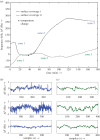Investigating biomechanical noise in neuroblastoma cells using the quartz crystal microbalance
- PMID: 25878129
- PMCID: PMC4424671
- DOI: 10.1098/rsif.2014.1389
Investigating biomechanical noise in neuroblastoma cells using the quartz crystal microbalance
Abstract
Quantifying cellular behaviour by motility and morphology changes is increasingly important in formulating an understanding of fundamental physiological phenomena and cellular mechanisms of disease. However, cells are complex biological units, which often respond to external environmental factors by manifesting subtle responses that may be difficult to interpret using conventional biophysical measurements. This paper describes the adaptation of the quartz crystal microbalance (QCM) to monitor neuroblastoma cells undergoing environmental stress wherein the frequency stability of the device can be correlated to changes in cellular state. By employing time domain analysis of the resulting frequency fluctuations, it is possible to study the variations in cellular motility and distinguish between different cell states induced by applied external heat stress. The changes in the frequency fluctuation data are correlated to phenotypical physical response recorded using optical microscopy under identical conditions of environmental stress. This technique, by probing the associated biomechanical noise, paves the way for its use in monitoring cell activity, and intrinsic motility and morphology changes, as well as the modulation resulting from the action of drugs, toxins and environmental stress.
Keywords: biomechanical noise; frequency stability; neuroblastoma cells; quartz crystal microbalance.
© 2015 The Author(s) Published by the Royal Society. All rights reserved.
Figures






Similar articles
-
Dynamic measurement of the surface stress induced by the attachment and growth of cells on Au electrode with a quartz crystal microbalance.Biosens Bioelectron. 2009 Feb 15;24(6):1603-9. doi: 10.1016/j.bios.2008.08.021. Epub 2008 Aug 22. Biosens Bioelectron. 2009. PMID: 18824347
-
Monitoring of cultured cell activity by the quartz crystal and the micro CCD camera under chemical stressors.Biosens Bioelectron. 2009 Jan 1;24(5):1318-23. doi: 10.1016/j.bios.2008.07.038. Epub 2008 Aug 5. Biosens Bioelectron. 2009. PMID: 18771912
-
Cardiac troponin T detection using polymers coated quartz crystal microbalance as a cost-effective immunosensor.Biomed Tech (Berl). 2010 Oct;55(5):279-84. doi: 10.1515/BMT.2010.036. Epub 2010 Sep 15. Biomed Tech (Berl). 2010. PMID: 20840005
-
Application of the quartz crystal microbalance to nanomedicine.J Biomed Nanotechnol. 2009 Dec;5(6):669-75. doi: 10.1166/jbn.2009.1083. J Biomed Nanotechnol. 2009. PMID: 20201228 Review.
-
A review of monolithic multichannel quartz crystal microbalance: a review.Anal Chim Acta. 2011 Feb 21;687(2):114-28. doi: 10.1016/j.aca.2010.12.022. Epub 2010 Dec 21. Anal Chim Acta. 2011. PMID: 21277413 Review.
References
MeSH terms
LinkOut - more resources
Full Text Sources
Other Literature Sources

